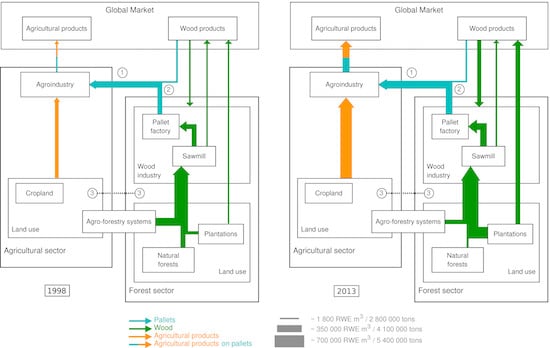Unexpected Interactions between Agricultural and Forest Sectors through International Trade: Wood Pallets and Agricultural Exports in Costa Rica
Abstract
:1. Introduction
2. Materials and Methods
2.1. Evolution over Time of Demand for Wood Pallets due to Agricultural Exports
2.2. How Costa Rica Has Met Its Demand for Wood Pallets over Time
2.3. Effects on Costa Rica’s Forestry Sector and Land Use
3. Results
3.1. Evolution over Time of Demand for Wood Pallets due to Agricultural Exports
3.2. How Costa Rica Has Met Its Demand for Wood Pallets Over Time
3.3. Effects on Costa Rica’s Forestry Sector and Land Use
4. Discussion
4.1. Growing Demand for Wood Pallets Met from Domestic Forest Plantations
4.2. Use of Plantations for Pallet Production: Competition with Natural Forests or Land Sparing?
4.3. Unexpected Feedbacks of International Trade on Costa Rica’s Land Use and Forestry Sector
4.4. Sustainability of Domestic Wood Production at Risk
5. Conclusions
Acknowledgments
Author Contributions
Conflicts of Interest
Appendix A
| Parameter | Value | Unit | Source | ||
|---|---|---|---|---|---|
| Average weight to be loaded on one pallet | Bananas | 0.86 | tons/pallet | [41,43,45,46,47,48,49,50,51], interviews | |
| Plantains | 1.06 | ||||
| Pineapples | 1.01 | ||||
| Melons | 1.01 | ||||
| Cassava | 1.01 | ||||
| Mangoes | 1.05 | ||||
| Oil palm | 0.96 | ||||
| Weight of European and American pallets | Minimum | 14 | kg | [54,55,56] | |
| Average | 22 | ||||
| Maximum | 28 | ||||
| Factors to convert weight into volume | Roundwood | No coniferous | 1.31 | m³/ton | [57,59,60] |
| Coniferous | 1.43 | ||||
| Sawnwood | No coniferous | 1.43 | |||
| Coniferous | 1.82 | ||||
| Roundwood requirements for pallet production | Minimum | 0.06 | m³/pallet | Interviews | |
| Weighted average | 0.084 | ||||
| Maximum | 0.1 | ||||
| Sawnwood requirements for pallet production | Minimum | 0.03 | |||
| Weighted average | 0.034 | ||||
| Maximum | 0.04 | ||||
| Fixed costs of converting sawnwood into finished pallets | Assembly | Minimum | 0.08 | $/pallet | Interviews |
| Average | 2.88 | ||||
| Maximum | 3.34 | ||||
| Heat treatment | Minimum | 0.50 | |||
| Average | 0.73 | ||||
| Maximum | 0.75 | ||||
| Commercialization | Minimum | 0.00 | |||
| Average | 1.12 | ||||
| Maximum | 2.55 | ||||
| Price of new pallets | Minimum | 7 | |||
| Maximum | 20 | ||||
| Productivity of Costa Rican forests | Natural forests | Minimum | 1 | m³/ha/yr | [67,68] |
| Maximum | 1.3 | ||||
| Forest plantations | Minimum | 12 | [69,70,79,80] | ||
| Average | 20 | ||||
| Maximum | 25 | ||||
| Conversion efficiency of roundwood into sawnwood | From natural forests | Minimum | 50 | % | [57] |
| Average | 60 | ||||
| Maximum | 70 | ||||
| From tree plantations | Minimum | 40 | |||
| Maximum | 50 | ||||
| Area of primary and secondary forests (excluding mangroves and tree plantations) | 1997 | 2,101,979 | ha | [71,72,73,74] | |
| 2000 | 2,318,500 | ||||
| 2005 | 2,447,690 | ||||
| 2012 | 2,518,423 | ||||
| Percentage of newly produced pallets in the World (2009) | 21 | % | [76] | ||
| Annual increase of reusable pallets in the World (since 1994) | 2.5 | % | |||
| Average mean annual increment of forest plantations | USA and Europe | 9 | m³/ha/yr | [70,77,78] | |
| Central America | 12 | ||||
| Ecuador, Colombia, Venezuela | 15 | ||||
| Brazil | 20 | ||||
| Argentina | 22 | ||||
| Chile | 24 | ||||
References
- Walker, R.T. Land use transistion and deforestation in developing countries. Geogr. Anal. 1987, 19. [Google Scholar] [CrossRef]
- Rudel, T.K. Paths of destruction and regeneration: Globalization and forests in the tropics. Rural Sociol. 2002, 67, 622–636. [Google Scholar] [CrossRef]
- Laurance, W.F. Emerging Threats to Tropical Forests. Ann. Missouri Bot. Gard. 2015, 100, 159–169. [Google Scholar] [CrossRef]
- Gibbs, H.K.; Ruesch, A.S.; Achard, F.; Clayton, M.K.; Holmgren, P.; Ramankutty, N.; Foley, J.A. Tropical forests were the primary sources of new agricultural land in the 1980s and 1990s. Proc. Natl. Acad. Sci. USA 2010, 107, 16732–16737. [Google Scholar] [CrossRef] [PubMed]
- Graesser, J.; Aide, T.M.; Grau, H.R.; Ramankutty, N. Cropland/pastureland dynamics and the slowdown of deforestation in Latin America. Environ. Res. Lett. 2015, 10. [Google Scholar] [CrossRef]
- Mather, A.S.; Needle, C.L. The forest transition: A theoretical basis. Area 1998, 30, 117–124. [Google Scholar] [CrossRef]
- Rudel, T.K.; Schneider, L.; Uriarte, M.; Turner, B.L.; DeFries, R.; Lawrence, D.; Geoghegan, J.; Hecht, S.; Ickowitz, A.; Lambin, E.F.; et al. Agricultural intensification and changes in cultivated areas, 1970–2005. Proc. Natl. Acad. Sci. USA 2009, 106, 20675–20680. [Google Scholar] [CrossRef] [PubMed]
- Redo, D.J.; Grau, H.R.; Aide, T.M.; Clark, M.L. Asymmetric forest transition driven by the interaction of socioeconomic development and environmental heterogeneity in Central America. Proc. Natl. Acad. Sci. USA 2012, 109, 8839–8844. [Google Scholar] [CrossRef] [PubMed]
- Phalan, B.; Green, R.E.; Dicks, L.V.; Dotta, G.; Lamb, A.; Bernardo, B.N.; Williams, D.R.; Ermgassen, K.H.J.; Balmford, A. How can higher-yield farming help to spare nature? Science 2016, 351, 450–451. [Google Scholar] [CrossRef] [PubMed]
- Angelsen, A.; Kaimowitz, D. Agricultural Technologies and Tropical Deforestation; CABI International: New York, NY, USA, 2001. [Google Scholar]
- Angelsen, A. Forest Cover Change in Space and Time: Combining the von Thünen and Forest Transition Theories. World Bank Policy Research Working Paper 4117; World Bank: Washington, DC, USA, 2007. [Google Scholar]
- Lambin, E.F.; Meyfroidt, P. Global land use change, economic globalization, and the looming land scarcity. Proc. Natl. Acad. Sci. USA 2011, 108, 3465–3472. [Google Scholar] [CrossRef] [PubMed]
- Erb, K.-H.; Krausmann, F.; Lucht, W.; Haberl, H. Embodied HANPP: Mapping the spatial disconnect between global biomass production and consumption. Ecol. Econ. 2009, 69, 328–334. [Google Scholar] [CrossRef]
- Meyfroidt, P.; Lambin, E.F.; Erb, K.-H.; Hertel, T.W. Globalization of land use: distant drivers of land change and geographic displacement of land use. Curr. Opin. Environ. Sustain. 2013, 5, 438–444. [Google Scholar] [CrossRef]
- Würtenberger, L.; Koellner, T.; Binder, C.R. Virtual land use and agricultural trade: Estimating environmental and socio-economic impacts. Ecol. Econ. 2006, 57, 679–697. [Google Scholar] [CrossRef]
- Grau, H.R.; Aide, M. Globalization and Land-use transitions in Latin America. Ecol. Soc. 2008, 13, 16. [Google Scholar] [CrossRef]
- Liu, J.; Dietz, T.; Carpenter, S.R.; Alberti, M.; Folke, C.; Moran, E.; Pell, A.N.; Deadman, P.; Kratz, T.; Lubchenco, J.; et al. Complexity of coupled human and natural systems. Science 2007, 317, 1513–1516. [Google Scholar] [CrossRef] [PubMed]
- Verburg, P.H.; Crossman, N.; Ellis, E.C.; Heinimann, A.; Hostert, P.; Mertz, O.; Nagendra, H.; Sikor, T.; Erb, K.-H.; Golubiewski, N.; et al. Land system science and sustainable development of the earth system: A global land project perspective. Anthropocene 2015, 12, 29–41. [Google Scholar] [CrossRef] [Green Version]
- FAO. Global Forest Resources Assessment 2005. Progress towards Sustainable Forest Management; FAO Forestry Paper No. 147; FAO: Rome, Italy, 2006. [Google Scholar]
- FAO. Global Forest Resources Assessment 2010. Main Report; FAO Forestry Paper No. 163; FAO: Rome, Italy, 2010. [Google Scholar]
- FAO. Global Forest Resources Assessment 2015; FAO: Rome, Italy, 2015. [Google Scholar]
- Sloan, S.; Sayer, J.A. Forest Resources Assessment of 2015 shows positive global trends but forest loss and degradation persist in poor tropical countries. For. Ecol. Manage. 2015, 352, 134–145. [Google Scholar] [CrossRef]
- Van Holt, T.; Binford, M.W.; Portier, K.M.; Vergara, R. A stand of trees does not a forest make: Tree plantations and forest transitions. Land Use Pol. 2016, 56, 147–157. [Google Scholar] [CrossRef]
- Payn, T.; Carnus, J.M.; Freer-Smith, P.; Kimberley, M.; Kollert, W.; Liu, S.; Orazio, C.; Rodriguez, L.; Silva, L.N.; Wingfield, M.J. Changes in planted forests and future global implications. For. Ecol. Manage. 2015, 352, 57–67. [Google Scholar] [CrossRef]
- Pirard, R.; Dal Secco, L.; Warman, R. Do timber plantations contribute to forest conservation? Environ. Sci. Policy 2016, 57, 122–130. [Google Scholar] [CrossRef]
- Heilmayr, R. Conservation through intensification? The effects of plantations on natural forests. Ecol. Econ. 2014, 105, 204–210. [Google Scholar] [CrossRef]
- Sembres, T.; Kontoleon, A.; Brown, C. Understanding the Impact of Timber Plantations on Tropical Deforestation: A Cross Country Analysis; 2009. Available online: http://bioecon-network.org/pages/11th_2009/Sembres.pdf (accessed on 22 December 2016).
- Heilmayr, R.; Echeverría, C.; Fuentes, R.; Lambin, E.F. A plantation-dominated forest transition in Chile. Appl. Geogr. 2016, 75, 71–82. [Google Scholar] [CrossRef]
- Kaimowitz, D. Livestock and Deforestation in Central America in the 1980s and 1990s: A Policy Perspective; Center for International Forestry Research: Jakarta, Indonesia, 1996. [Google Scholar]
- Kleinn, C.; Corrales, L.; Morales, D. Forest area in Costa Rica: A comparative study of tropical forest cover estimates over time. Environ. Monit. Assess. 2002, 73, 17–40. [Google Scholar] [CrossRef] [PubMed]
- Chomitz, K.M.; Brenes, E.; Constantino, L. Financing environmental services: the Costa Rican experience and its implications. Sci. Total Environ. 1999, 240, 157–169. [Google Scholar] [CrossRef]
- De Camino, R.; Segura, O.; Arias, L.G.; Pérez, I. Costa Rica Forest Strategy and the Evolution of Land Use; Evaluation Country Case Study Series; World Bank: Washington, DC, USA, 2000. [Google Scholar]
- Kull, C.A.; Ibrahim, C.K.; Meredith, T.C. Tropical forest transitions and globalization: Neo-liberalism, migration, tourism, and international conservation agendas. Soc. Nat. Resour. 2007, 20, 723–737. [Google Scholar] [CrossRef]
- Brown, J.; Bird, N. Costa Rica’s Sustainable Resource Management: Successfully Tackling Tropical Deforestation; ODI publications: London, UK, 2011. [Google Scholar]
- Calvo, J. Decimoquinto Informe Estado de la Nación en Desarrollo Humano Sostenible. Informe Final. Bosque, cobertura y recursos forestales 2008; Estado de la Nación: San José, Costa Rica, 2008. [Google Scholar]
- Mather, A.S. The forest transition. Area 1992, 24, 367–379. [Google Scholar]
- Jadin, I.; Meyfroidt, P.; Lambin, E.F. International trade, and land use intensification and spatial reorganization explain Costa Rica’s forest transition. Environ. Res. Lett. 2016, 11, 049502. [Google Scholar] [CrossRef]
- Byerlee, D.; Stevenson, J.; Villoria, N. Does intensification slow crop land expansion or encourage deforestation? Glob. Food Sec. 2014, 3, 92–98. [Google Scholar] [CrossRef]
- L.C.N. Inc. The history and the evolution of wood pallets. Available online: http://en.lcn-pal.com/wooden-pallets/Articles/The-history-and-the-evolution-of-wood-pallets.aspx (accessed on 22 December 2016).
- NWPCA. Pallets move the world. Available online: https://www.palletcentral.com/ (accessed on 22 December 2016).
- Barrantes, A.R.; Salazar, G.C.; Paniagua, R. Usos y aportes de la madera en Costa Rica. Estadísticas 2010; Oficina Nacional Forestal: San José, Costa Rica, 2011. [Google Scholar]
- FAO. FAOSTAT. Available online: http://faostat.fao.org/ (accessed on 22 December 2016).
- Barrantes, A.R.; Ugalde, S.A. Usos y aportes de la madera en Costa Rica. Estadísticas 2013; Oficina Nacional Forestal: San José, Costa Rica, 2014. [Google Scholar]
- UN. UN Comtrade Database. Available online: Comtrade Database http://comtrade.un.org/ (accessed on 22 December 2016).
- Barrantes, A.R.; Salazar, C.G.; Salas, V.N. Usos y aportes de la madera en Costa Rica. Estadísticas 2008; Oficina Nacional Forestal: San José, Costa Rica, 2009. [Google Scholar]
- Barrantes, A.R.; Salazar, G.C. Usos y aportes de la madera en Costa Rica. Estadísticas 2009; Oficina Nacional Forestal: San José, Costa Rica, 2010. [Google Scholar]
- Barrantes, A.R.; Salazar, G.C. Usos y aportes de la madera en Costa Rica. Estadísticas 2006; Oficina Nacional Forestal: San José, Costa Rica, 2007. [Google Scholar]
- Barrantes, A.R.; Salazar, G.C. Usos y aportes de la madera en Costa Rica. Estadísticas 2007; Oficina Nacional Forestal: San José, Costa Rica, 2008. [Google Scholar]
- Barrantes, A.R.; Ugalde, S.A. Usos y aportes de la madera en Costa Rica. Estadísticas 2012; Oficina Nacional Forestal: San José, Costa Rica, 2013. [Google Scholar]
- Barrantes, A.R.; Ugalde, S.A. Usos y aportes de la madera en Costa Rica. Estadísticas 2014; Oficina Nacional Forestal: San José, Costa Rica, 2015. [Google Scholar]
- Barrantes, A.R.; Ugalde, S.A. Usos y aportes de la madera en Costa Rica. Estadísticas 2011; Oficina Nacional Forestal: San José, Costa Rica, 2012. [Google Scholar]
- Zeileis, A. Econometric computing with HC and HAC covariance matrix estimators. J. Stat. Softw. 2004, 11, 1–17. [Google Scholar] [CrossRef]
- Procomer Promotora de Comercio Exterior de Costa Rica. Available online: http://www.procomer.com/ (accessed on 22 December 2016).
- Wim Bosman Group Pallets & packaging types. Available online: http://www.mainfreight.nl/en/info_point/info_point_transport/pallets_en_packaging_types.aspx (accessed on 22 December 2016).
- Greenway Products & Services LLC Pallet Weight. Available online: http://greenwaypsllc.com/pallet-weight/ (accessed on 22 December 2016).
- CHEP Wooden Pallet - 1200 x 1000 mm. Available online: http://www.chep.com/Pallets/Wooden-Pallet-1200-x-1000-mm-(8001)/ (accessed on 22 December 2016).
- Santamaria, O.J.G. Los acervos de carbono en productos de madera y derivados en Costa Rica.; BM; REDD+; FONAFIFO; ONF: San José, Costa Rica, 2015. [Google Scholar]
- Verbeek, M. A Guide to Modern Econometrics, 2nd ed.; John Wiley and Sons Ltd.: Chichester, UK, 2004. [Google Scholar]
- UNECE; FAO. Forest Product Conversion Factors for the UNECE Region; Geneva Timber and Forest Discussion Paper 49; United Nationas Economic Commission for Europe (UNECE); Food and Agriculture Organization of the United Nations (FAO): Geneva, Switzerland, 2010. [Google Scholar]
- ITTO. Annual Review and Assessment of the World Timber Situation 2012; International Tropical Timber Organization: Yokohama, Japan, 2012. [Google Scholar]
- Barrantes, A.R.; Salazar, G.C. Precios de referencia de la madera en Costa Rica (2008); Oficina Nacional Forestal: San José, Costa Rica, 2008. [Google Scholar]
- Salazar, G.C.; Salas, N.V. Precios de la madera en Costa Rica. Primer semestre 2009; Oficina Nacional Forestal: San José, Costa Rica, 2009. [Google Scholar]
- Paniagua, R.V.; Salazar, G.C. Precios de la Madera en Costa Rica 2011 y tendencias de las principales especies comercializadas; Oficina Nacional Forestal: San José, Costa Rica, 2011. [Google Scholar]
- Ugalde, S.A. Precios de la madera para las especies mas comercializadas. Primer semestre, 2012; Oficina Nacional Forestal: San José, Costa Rica, 2012. [Google Scholar]
- Barrantes, A.R.; Ugalde, S.A. Precios de la madera para las especies mas comercializadas. Primer semestre del 2014; Oficina Nacional Forestal: San José, Costa Rica, 2014. [Google Scholar]
- ONF. Precios de la madera para las especies mas comercializadas. Costa Rica, primer semestre, 2013; Oficina Nacional Forestal: San José, Costa Rica, 2013. [Google Scholar]
- Louman, B. Costa Rica. In Sustainable Management of Tropical Rainforests: The CELOS Management System; Werger, M.J.A., Ed.; Tropenbos International: Paramaribo, Suriname, 2011; pp. 213–225. [Google Scholar]
- Arce, H.B.; Barrantes, A.R. La madera en Costa Rica. Situación Actual y Perspectivas; Oficina Nacional Forestal (ONF); Fondo Nacional de Financiamiento Forestal (FONAFIFO): San José, Costa Rica, 2006. [Google Scholar]
- Moya, R.R. Gmelina arborea en Costa Rica. In Bois et Forêts des Tropiques 279 (1); CIRAD: Cartago, Costa Rica, 2004; pp. 1–11. [Google Scholar]
- Brown, C. The global outlook for future wood supply from forest plantations. Working paper GFPOS/WP/03; FAO: Rome, Italy, 2000. [Google Scholar]
- Mckenzie, T.A. Tendencias y perspectivas para el sector forestal de Costa Rica hasta el año 2020; Comisión Forestal de América Latina y el Caribe: San Jose, Costa Rica, 2003. [Google Scholar]
- Sánchez, A.A.; Foley, S.; Hamilton, S.; César, J.C.; Arroyo, P.; Jiménez, V. Estudio de Corbertura Forestal de Costa Rica con imagenes Landsat TM 7 para al año 2000; Laboratorio de Sistemas de Observación Terrestre (EOSL); Centro Científico Tropical (CCT); Fondo Nacional de Financiamiento Forestal de Costa Rica (FONAFIFO): San José, Costa Rica, 2002. [Google Scholar]
- Sánchez-Azofeifa, A.; Calvo-Alvarado, J.; Chong, M.; Castillo, M.; Jiménez, V. Estudio de Monitoreo de Cobertura Forestal de Costa Rica 2005. Parte 1: Clasificación de la Cobertura Forestal con Imágenes Landsat ETM+ 2005; Alberta University; Instituto Tecnológico de Costa Rica; Fondo Nacional de Financiamiento Forestal (FONAFIFO): San José, Costa Rica, 2007. [Google Scholar]
- SINAC; FONAFIFO. Inventario Forestal Nacional de Costa Rica; Sistema Nacional de Áreas de Conservación (SINAC); Fondo de Financiamineto Forestal de Costa Rica (FONAFIFO): San José, Costa Rica, 2015. [Google Scholar]
- CONARE. Programa Estado de la Nación. Available online: http://www.estadonacion.or.cr/ (accessed on 22 December 2016).
- HIRSCH. Servo Group Pallet market in general. Available online: http://www.hirsch-gruppe.com/homepage/com/geschaeftsfelder/Paletten/Produkte.php?navid=82 (accessed on 22 December 2016).
- FAO. Global Fibre Supply Model; Food and Agriculture Organization of the United Nations: Rome, Italy, 1988. [Google Scholar]
- Del Lungo, A.; Ball, J.; Carle, J. Global Planted Forests Thematic Study. Results and Analysis; Planted Forest and Trees Working Paper 38; FAO: Rome, 2006. [Google Scholar]
- Serrano, R.; Moya, R. Procesamiento, uso y mercado de la madera en Costa Rica: aspectos históricos y análisis crítico. Rev. For. Mesoam. Kurú 2011, 8, 1–12. [Google Scholar]
- Rojas, F.R.; Arias, D.A.; Moya, R.R.; Meza, A.M.; Murillo, O.G.; Arguedas, M.G. Manual para productores de Melina (Gmelina arborea) en Costa Rica; Centro de Investigación en Integración Bosque Industria de la Escuela de Ingeniería Forestal del Instituto Tecnológico de Costa Rica: Cartago, Costa Rica, 2004. [Google Scholar]
- Vásquez, Al.R. Producción forestal - fundamentos; Eidtorial Universidad Estatal a Distancia: San José, Costa Rica, 2007. [Google Scholar]
- Miranda, M.; Otoya, M.; Venegas, I. Estrategías y mecanismos financieros para la conservación y uso sostenible de los bosques en América Latina - Estudio de caso: Costa Rica; FAO; IUCN: San José, Costa Rica, 2005. [Google Scholar]
- Baltodano, J. Decimotercer Informe Estado de la Nación en Desarrollo Humano Sostenible. Informe Final. Bosque, cobertura y uso forestal; Consejo Nacional de Rectores, La Defensoría de los Habitantes: San José, Costa Rica, 2007. [Google Scholar]
- PEN. Compendio ambiental 2015; Programa Estado de la Nación (PEN): San José, Costa Rica, 2015. [Google Scholar]
- Porras, I.; Barton, D.N.; Miranda, M.; Chacón-Cascante, A. Learning from 20 years of Payments for Ecosystem Services in Costa Rica; International Institute for Environment and Development: London, UK, 2013. [Google Scholar]
- Bennett, K.; Henninger, N. Payments for Ecosystem Services in Costa Rica and Forest Law No. 7575: Key Lessons for Legislators; World Resource Institute: Washington, DC, USA, 2009. [Google Scholar]
- Arce, J.J.C.; Soto, R.V.; Calvo, M.C.; Flores, M.G.; Rodríguez, C.M. La tala ilegal en Costa Rica. Un análisis para la discusión; CATIE: Turrialba, Costa Rica, 2001. [Google Scholar]
- FONAFIFO. REDD+ Costa Rica. Available online: http://reddcr.go.cr/ (accessed on 22 December 2016).
- Echeverria, C.; Coomes, D.; Salas, J.; Rey-Benayas, J.M.; Lara, A.; Newton, A. Rapid deforestation and fragmentation of Chilean temperate forests. Biol. Conserv. 2006, 130, 481–494. [Google Scholar] [CrossRef]
- Zurita, G.A.; Rey, N.; Varela, D.M.; Villagra, M.; Bellocq, M.I. Conversion of the Atlantic Forest into native and exotic tree plantations: Effects on bird communities from the local and regional perspectives. For. Ecol. Manag. 2006, 235, 164–173. [Google Scholar] [CrossRef]
- Fagan, M.E.; DeFries, R.S.; Sesnie, S.E.; Arroyo, J.P.; Walker, W.; Soto, C.; Chazdon, R.L.; Sanchun, A. Land cover dynamics following a deforestation ban in northern Costa Rica. Environ. Res. Lett. 2013, 8, 034017. [Google Scholar] [CrossRef]
- Lugo, A.E. The apparent paradox of reestablishing species richness on degraded lands with tree monocultures. For. Ecol. Manage. 1997, 99, 9–19. [Google Scholar] [CrossRef]
- Montagnini, F. Strategies for the recovery of degraded ecosystems: Experiences from Latin America. Interciencia 2001, 26, 498–503. [Google Scholar]
- Mishra, A.; Sharma, S.D.; Khan, G.H. Improvement in physical and chemical properties of sodic soil by 3, 6 and 9 years old plantation of Eucalyptus tereticornis. For. Ecol. Manage. 2003, 184, 115–124. [Google Scholar] [CrossRef]
- OET. El abastecimiento sostenible de madera en Costa Rica; OET: San José, Costa Rica, 2008. [Google Scholar]
- De Camino, R.; Morales-Aymerich, J.P. Informe de caracterización de las acciones implementadas por Costa Rica en los últimos 25 años en el sector forestal; Centro Agronómico Tropical de Investigación y enseñanza: Turrialba, Costa Rica, 2015. [Google Scholar]
- Clapp, R.A. Tree farming and forest conservation in Chile: Do replacement forests leave any originals behind? Soc. Nat. Resour. 2001, 14, 341–356. [Google Scholar] [CrossRef]
- Obando, G.V. Decimosexto Informe Estado de la Nación en Desrarollo Humano Sostenible. Informe Final. Bosque, cobertura y recursos forestales, 2009; Estado de la Nación: San José, Costa Rica, 2009. [Google Scholar]
- Arroyo-Mora, J.; Svob, S.; Kalacska, M.; Chazdon, R. Historical patterns of natural forest management in Costa Rica: The good, the bad and the ugly. Forests 2014, 5, 1777–1797. [Google Scholar] [CrossRef]
- Arce, H.B.; Barrantes, A.R. La madera en Costa Rica. Situación Actual y Perspectivas; Oficina Nacional Forestal (ONF); Fondo Nacional de Financiamiento Forestal (FONAFIFO): San José, Costa Rica, 2004. [Google Scholar]
- CCF. Oportunidades de mercadeo y comercialización internacional de las maderas tropicales y de sus manufacturas: la experiencia del caso de la melina en Costa Rica y de la unidad de comercialización de la CCF; Camara Costaricense Forestal: San José, Costa Rica, 1997. [Google Scholar]
- Köhlin, G.; Parks, P. Spatial variability and disincentives to harvest: Deforestation and fuelwood collection in South Asia. Land Econ. 2001, 77, 206–218. [Google Scholar] [CrossRef]
- Barrantes, A.R. Desabastecimiento de madera en Costa Rica y consecuencias. Ambientico 2008, 183, 3–5. [Google Scholar]
- Barbier, B.; Burgess, J.C. The economic of tropical forest land use options. Land Econ. 1997, 73, 174–195. [Google Scholar] [CrossRef]
- De Sy, V.; Herold, M.; Achard, F.; Beuchle, R.; Clevers, J.G.P.W.; Lindquist, E.; Verchot, L. Land use patterns and related carbon losses following deforestation in South America. Environ. Res. Lett. 2015, 10, 124004. [Google Scholar]
- Henders, S.; Persson, U.M.; Kastner, T. Trading forests: land-use change and carbon emissions embodied in production and exports of forest-risk commodities. Environ. Res. Lett. 2015, 10, 125012. [Google Scholar] [CrossRef]
- Espinoza, A. Producción y demande de madera en Costa Rica. Ambientico 2008, 180, 1–17. [Google Scholar]
- Geels, F.W. Technological transitions as evolutionary reconfiguration processes: a multi-level perspective and a case-study. Res. Policy 2002, 31, 1257–1274. [Google Scholar] [CrossRef]
- Berkhout, F. Technological regimes, path dependency and the environment. Glob. Environ. Chang. 2002, 12, 1–4. [Google Scholar] [CrossRef]
- Unruh, G. Understanding carbon lock-in. Energy Policy 2000, 28, 817–830. [Google Scholar] [CrossRef]
- Laborde, S.; Fernández, A.; Phang, S.C.; Hamilton, I.M.; Henry, N.; Jung, H.C.; Mahamat, A.; Ahmadou, M.; Labara, B.K.; Kari, S.; et al. Social-ecological feedbacks lead to unsustainable lock-in in an inland fishery. Glob. Environ. Chang. 2016, 41, 13–25. [Google Scholar] [CrossRef]
- Laurance, W.F.; Sayer, J.; Cassman, K.G. Agricultural expansion and its impacts on tropical nature. Trends Ecol. Evol. 2013, 29, 107–116. [Google Scholar] [CrossRef] [PubMed]
- Redo, D.J.; Aide, T.M.; Clark, M.L.; Andrade-Nunez, M.J. Impacts of internal and external policies on land change in Uruguay, 2001–2009. Environ. Conserv. 2012, 39, 122–131. [Google Scholar] [CrossRef]
- Hernández, L.G.S.; Barquero, A.I.E.; Sánchez, H.T.; Hernández, W.C.; Ávila, C.A.; Murillo, R.C. Vigésimo Informe. Estado de la Nación en Desarrollo Humano Sostenible. Informe final: Recursos forestales; Programa Estado de la Nación: San José, Costa Rica, 2013. [Google Scholar]
- ÖBf; IUCN. Country Dialogue on the Role of the Private Sector in REDD+ in Costa Rica; Österreichische Bundesforste AG (ÖBf); International Union for Conservation of Nature (IUCN): San José, Costa Rica, 2014. [Google Scholar]
- Phelps, J.; Carrasco, L.R.; Webb, E.L.; Koh, L.P.; Pascual, U. Agricultural intensification escalates future conservation costs. Proc. Natl. Acad. Sci. USA 2013, 110, 7601–7606. [Google Scholar] [CrossRef] [PubMed]
- Liu, J.; Mooney, H.; Hull, V.; Davis, S.; Gaskell, J.; Hertel, T.; Lubchenco, J.; Seto, K.; Gleick, P.; Kremen, C.; Li, S. Systems integration for global sustainability. Science 2015, 347. [Google Scholar] [CrossRef] [PubMed]
- ProChile. Estudio de Mercado Madera Aserrada para el Mercado de Costa Rica; ProChile: San José, Costa Rica, 2011. [Google Scholar]
- INFOR. Anuario Forestal 2015. Chilean statistical yearbook of forestry. Boletín Estadístico No. 150; INFOR: Santiago, Chile, 2015. [Google Scholar]
- INFOR. Exportaciones Forestales Chilenas Marzo 2016; INFOR: Santiago, Chile, 2016. [Google Scholar]
- Zamorano-Elgueta, C.; Rey Benayas, J.M.; Cayuela, L.; Hantson, S.; Armenteras, D. Native forest replacement by exotic plantations in southern Chile (1985–2011) and partial compensation by natural regeneration. For. Ecol. Manage. 2015, 345, 10–20. [Google Scholar] [CrossRef] [Green Version]
- Heilmayr, R.; Lambin, E.F. Impacts of nonstate, market-driven governance on Chilean forests. Proc. Natl. Acad. Sci. 2016, 113, 2910–2915. [Google Scholar] [CrossRef] [PubMed]
- 1Since 2002, all wood packaging material destined for export must be subjected to a heat treatment and certified according to the International Standards For Phytosanitary Measures (ISPM) N°15, adopted by the Interim Commission on Phytosanitary Measures (ICPM) [115].
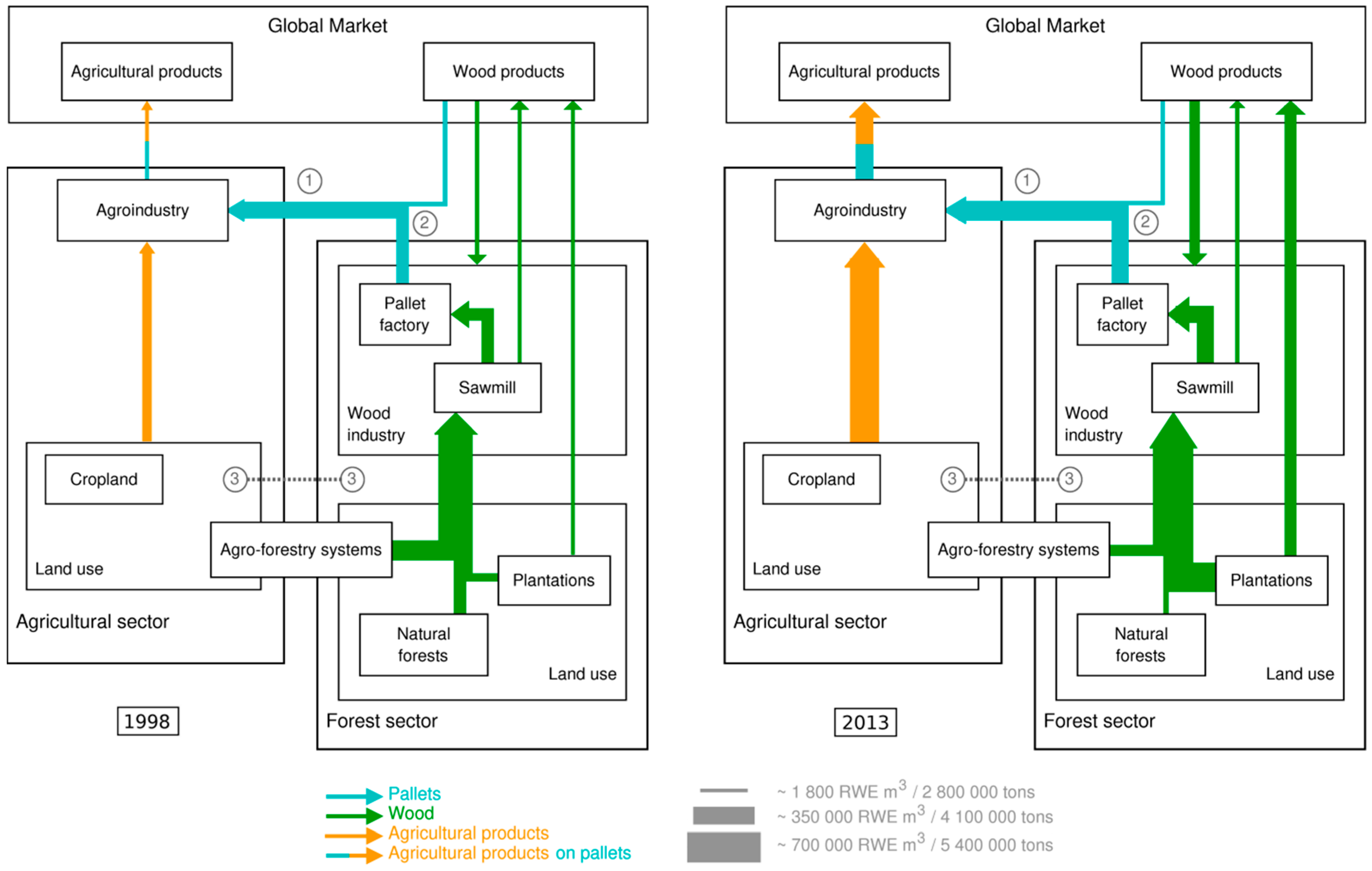
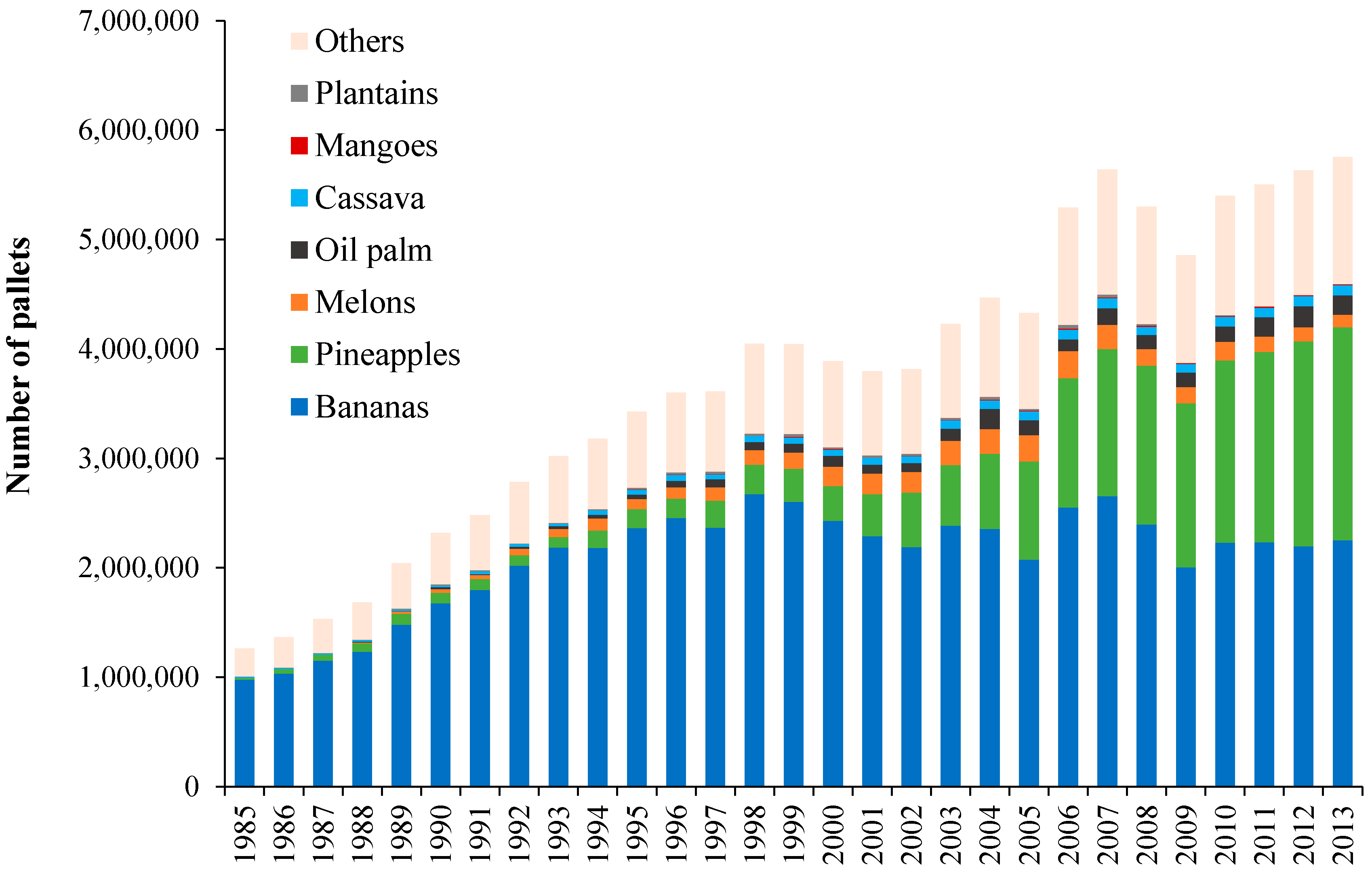
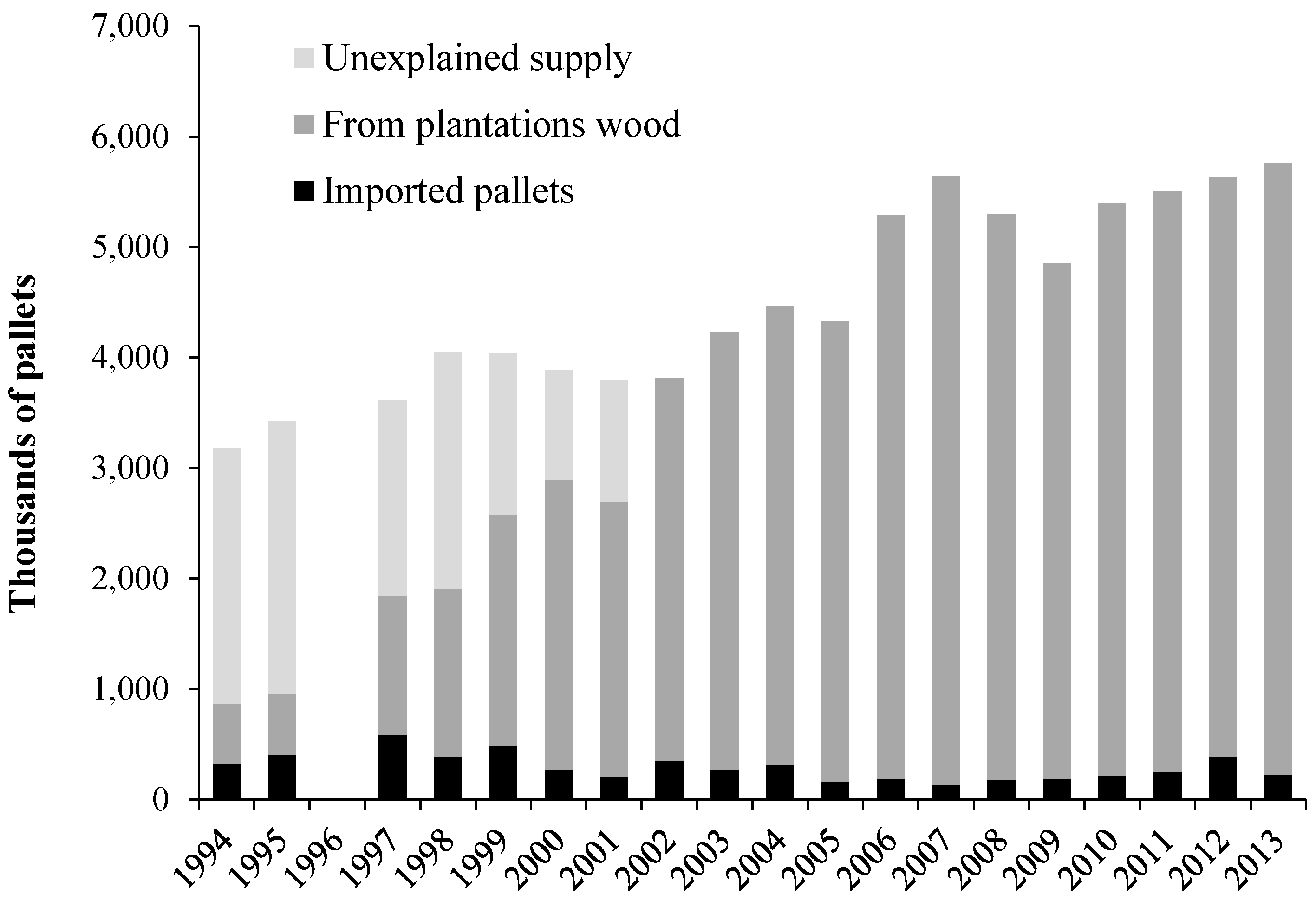
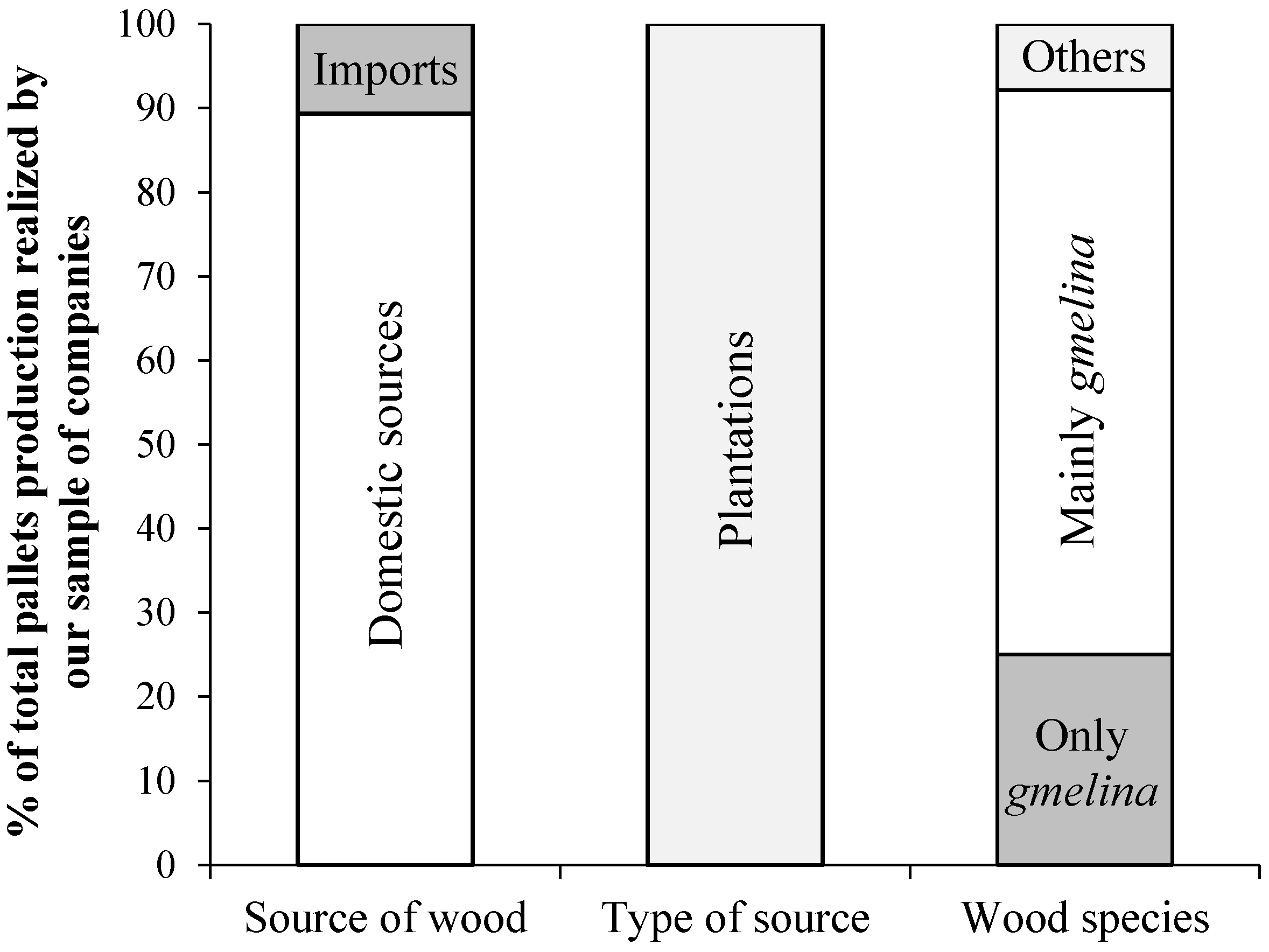
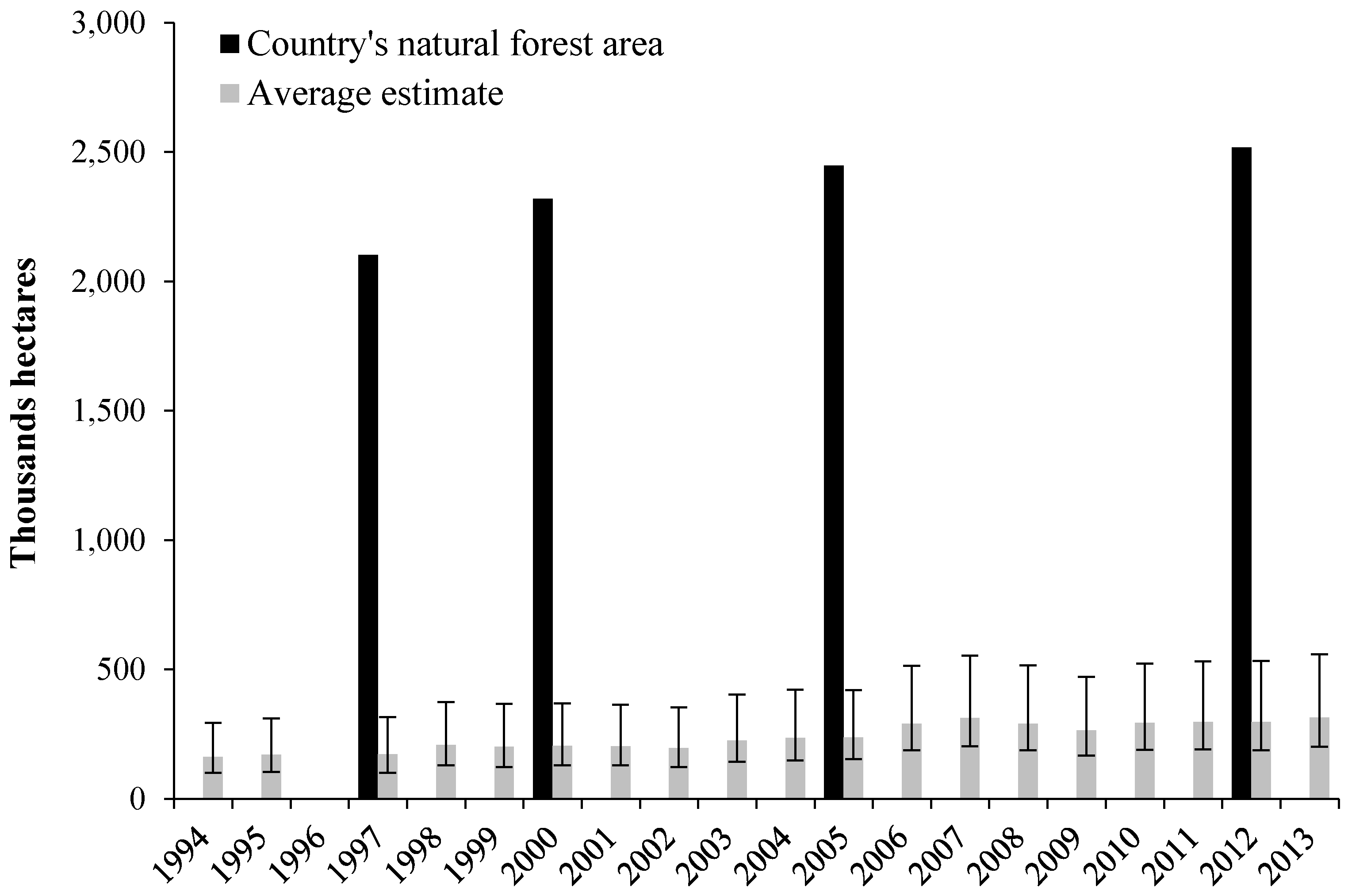

| Components of the Land Demand | Agricultural | Plantations | Imports |
|---|---|---|---|
| Accumulated expansion/contraction (ha.yr) | 667 008 | 185 060 | −7 585 |
| % of the agricultural component | 100 | 27.7 | −1.14 |
© 2016 by the authors. Licensee MDPI, Basel, Switzerland. This article is an open access article distributed under the terms and conditions of the Creative Commons Attribution (CC BY) license ( http://creativecommons.org/licenses/by/4.0/).
Share and Cite
Jadin, I.; Meyfroidt, P.; Zamora Pereira, J.C.; Lambin, E.F. Unexpected Interactions between Agricultural and Forest Sectors through International Trade: Wood Pallets and Agricultural Exports in Costa Rica. Land 2017, 6, 1. https://doi.org/10.3390/land6010001
Jadin I, Meyfroidt P, Zamora Pereira JC, Lambin EF. Unexpected Interactions between Agricultural and Forest Sectors through International Trade: Wood Pallets and Agricultural Exports in Costa Rica. Land. 2017; 6(1):1. https://doi.org/10.3390/land6010001
Chicago/Turabian StyleJadin, Isaline, Patrick Meyfroidt, Juan Carlos Zamora Pereira, and Eric F. Lambin. 2017. "Unexpected Interactions between Agricultural and Forest Sectors through International Trade: Wood Pallets and Agricultural Exports in Costa Rica" Land 6, no. 1: 1. https://doi.org/10.3390/land6010001





